HISTORY
HISTORY

Since 1814 “Philiki Etaireia”, or “Society of Friends”, paved the way for the uprising of the Greeks against the Turks, by organizing the Revolution.

“The vow” by Dionisios Tsokos
21/03/1821
Siege of Kalavryta, led by Sotiris Charalampi, A. Fotila, Sotiris Theocharopoulos, Ioannis Papadopoulos, Nikolaos Soliotis and Petimezaioi. The first military action of the Greek revolution will end victoriously after 5 days.
23/03/1821
Maniates, under the guidance of Theodoros Kolokotronis and Petrompei Mavromichali, occupy Kalamata. After this battle, the international community learns about the Greek revolution.
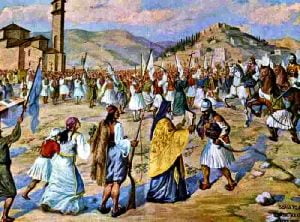
Representation of the “blessing” in Kalamata on March the 23rd, by the painter Evangelos Drakos
23/04/1821
Athanasios Diakos was defeated in the battle of Alamana by the Turkish forces under Kiose Mehmet and Omer Vryonis. His martyred death follows.
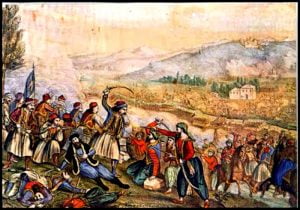
Alexandros Isaias painting, inspired by the battle of Alamana
08/05/1821
Victory of the Greeks led by Odysseas Androutsos in the battle of Gravia Inn. Lykourgos Logothetis declares revolution in Samos.
09/07/1821
Hanging of Cyprus Archbishop Kiprianos along with three other bishops upon order from the “Sublime Porte”. The massacres continued throughout Cyprus for 30 days.
“The Greeks are a race as old as the world, no one was able to annihilate them, no one, because God shelters them from up above. The Greek race will vanish, when the world comes to an end” Translated extract from “The 9th of July in Nicosia Cyprus” by Cypriot poet Vassilis Michaelides. Originally written in Cypriot dialect.
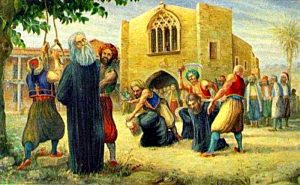
9th of July 1821 Cyprus
23/09/1821
Theodoros Kolokotronis conquers Tripolitsa after a siege. A strategic victory which secures control of the Peloponnese.
01/01/1822
Adoption of the first Constitution of Greece, in the First National Assembly of Epidaurus.
30/03/1822
The massacre of Chios. 42,000 Christians are slaughtered by the Ottoman army.
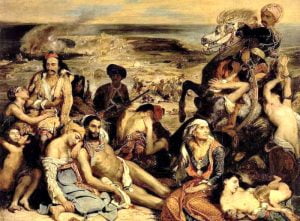
“The massacre of Chios” By Eugène Delacroix
In June 1822, the later Greek state Prime Minister Konstantinos Kanaris blasts the flagship of Kara Ali, the head of the Turks, who slaughtered the inhabitants of Chios
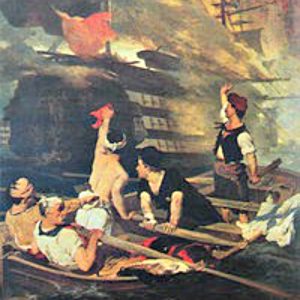
“Burning of the Turkish flagship by Kanaris” by Nikiforos Lytras
26/07/1822
Theodoros Kolokotronis destroys Dramalis’ army in the straits of Dervenakia. One of the biggest defeats of the Turks in Central Greece.
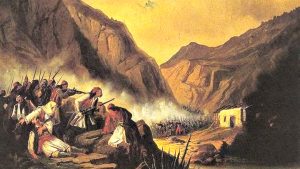
The battle of Dervenakia” by Theodore Vryzakis
August 1823
Markos Botsaris with the Souliotes and Kitsos Tzavelas (later General and Prime Minister) inflicts heavy losses on Mustafa Pasha’s forces in the Battle of Kefalovrysso. Markos Botsaris falls dead heroically.
Period 1823-1825
A black page in Greek Revolution history was the period during which the civil conflicts took place. Originally in the Peloponnese, the civil war between supporters of the government of Georgios Kountouriotis and the government of Petrobei Mavromichalis was ongoing. The Koundouriotis government eventually prevailed, offering amnesty to its opponents.
However, the riots continued and, as a result, Kolokotronis, who backed the Mavromichalis government, was imprisoned.
In Central Greece, a complete breach between Odysseas Androutsos and the revolutionary provisional government took place. In March 1825, Androutsos was defeated in Livanates by Giannis Gouras, who once was Androutsos’ second in command. Androutsos was imprisoned in Acropolis, but he later was assassinated prior to his trial.
20/05/1825
Death of heroic Papaflessas at the Battle of Maniaki. He fought against the Egyptian forces of Ibrahim.
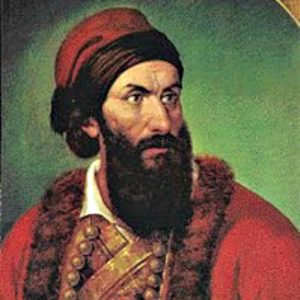
11/04/1826
“The sortie of Messolonghi”
After months under siege, the “free besieged” defenders of Messolonghi decide their heroic exit. The massacre of armed and civilian population by the Turkish-Egyptian forces followed. The fall of Messolonghi led to the resignation of the Kountouriotis government.
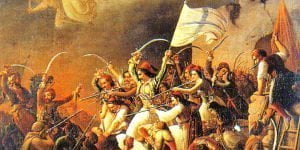
Snapshot from the painting “The sortie of Messolonghi” by Theodore Vryzakis
24/11/1826
Defeat of the Turks by George Karaiskakis in the Battle of Arachova. For the Turks it was the second major disaster after the Dervenakia defeat.
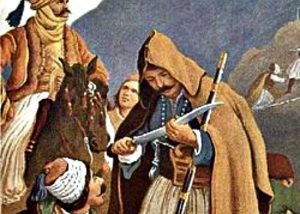
20/10/1827
“The naval battle of Navarino.” The fleet, consisting of naval forces of the United Kingdom, France and Russia, defeats the Turkish fleet of Ibrahim. An important development in favor of the Greek Revolution.
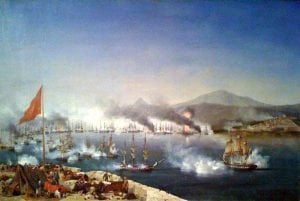
The naval battle of Navarino” by Ambroise Louis Garneray
03/04/1827
Election of Kapodistrias as the first Greek governor by the 3rd National Assembly of Trizina.

“Ioannis Kapodistrias” by Thomas Lawrence
3/02/1830
The London Protocol is signed. The independent Greek State is “born”
Women’s contribution to the Revolution
Laskarina Bouboulina, along with Manto Mavrogenous, were the two leading female figures of the Greek Revolution who not only bought warships at their own expense, but also participated in naval operations.

Bouboulina on the ship “Agamemnon” by German painter Peter von Hess
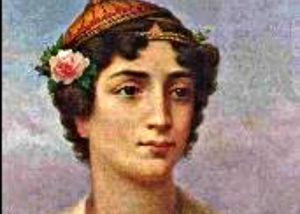
Lithograph of Manto Mavrogenous by Adam Friedel
Cyprus’ contribution to the nation’s struggles
Cyprus’ contribution to the Nation’s struggles was significant. Hundreds of Cypriots fought in the Peloponnese, Attica, Eastern Greece as well as in naval operations.
“Τhese were given to me by the heroism and bravery of Cypriots phalangists”
Quote of General, Christodoulos Hatzipetrou, regarding his medals

The flag of the “Phalanx of the Cypriots” during the Greek Revolution
March 25th was established as Independence Day and as an official holiday following a decree of King Otto in 1838. Together with the Greek Independence Day, the religious holiday of the Virgin Mary’s Annunciation is celebrated.
Today, the Greek Revolution is honored with military and student parades in Greece, Cyprus as well as by Hellenes Abroad.
Armenian Genocide Remembrance Day
On this day, 109 years ago, the genocide of the Armenian people by the Ottoman Empire began, with April 24 being the day of…
April 10, 1826 | The heroic Exodus of Messolonghi
Three years after the failed attempt of Kioutachis and Omer Vryonis to capture Messolonghi, the Sultan had a new plan.
Hellenic Army General Staff (HAGS) | Events for the 83rd Anniversary of the Battle of the Forts
On Sunday, April 7, 2024, the 83rd anniversary of the Battle of the Forts (April 6-9, 1941) was celebrated at “LISSE”, “RUPEL”,…
EUROSATORY 2024 | Missile Artillery Solutions from MBDA
With such a large number of interested attendees at MBDA’s pavilion at the Eurosatory 2024 Defence exhibition, the stand reminded of an…
KNDS | Showcases full range of LEOPARD battle tanks at EUROSATORY
KNDS continues to expand its technological advantage in the field of main battle tank development, as we have witnessed at the Defence and…
THEON SENSORS | Distinguishing appearance at EUROSATORY 2024 with new range of products
THEON SENSORS attended the International Defence and Security Exhibition EUROSATORY 2024 as an ambassador of Greek innovation…
Ministry of Defence | Organization of Hellenic EDF Info Day
A Conference entitled “EDF Info Day” is organized in the Amphitheater of the National Gallery on Tuesday, July 9 from 09:00 to 17:00.
ALTUS LSA | Participates in EUROSATORY 2024 with KERVEROS in the foreground
The participation of ALTUS LSA in EUROSATORY 2024 is among the Greek participations of operational significance.
Freddy Beleris | Ιn jail until October
The elected mayor of Heimarra and Member of the European Parliament of New Democracy will remain in prison until October…




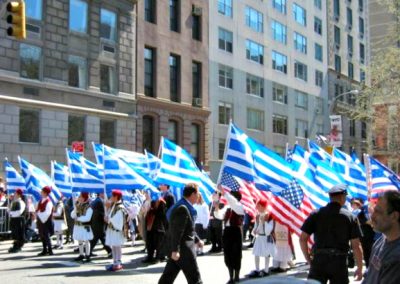
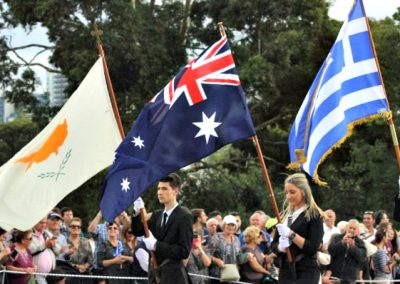
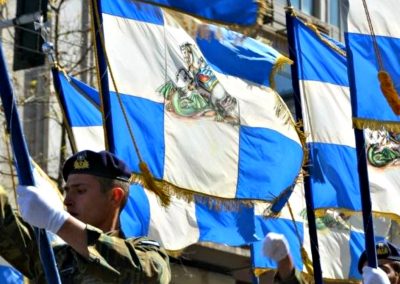
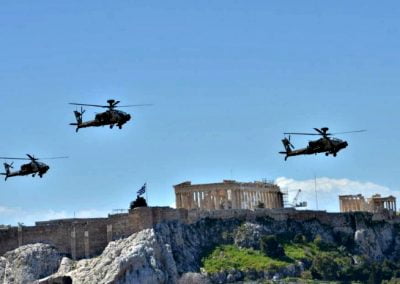















0 Comments